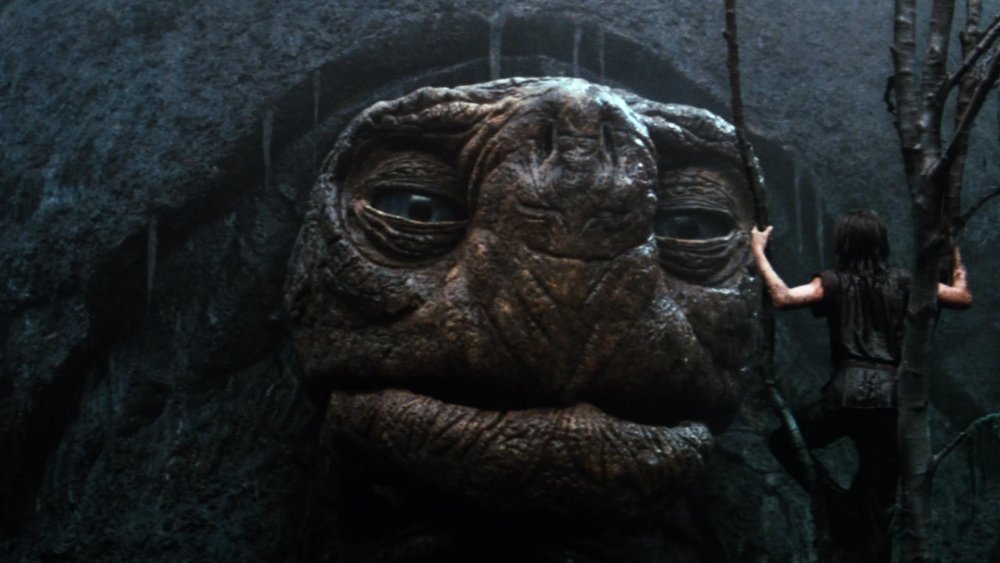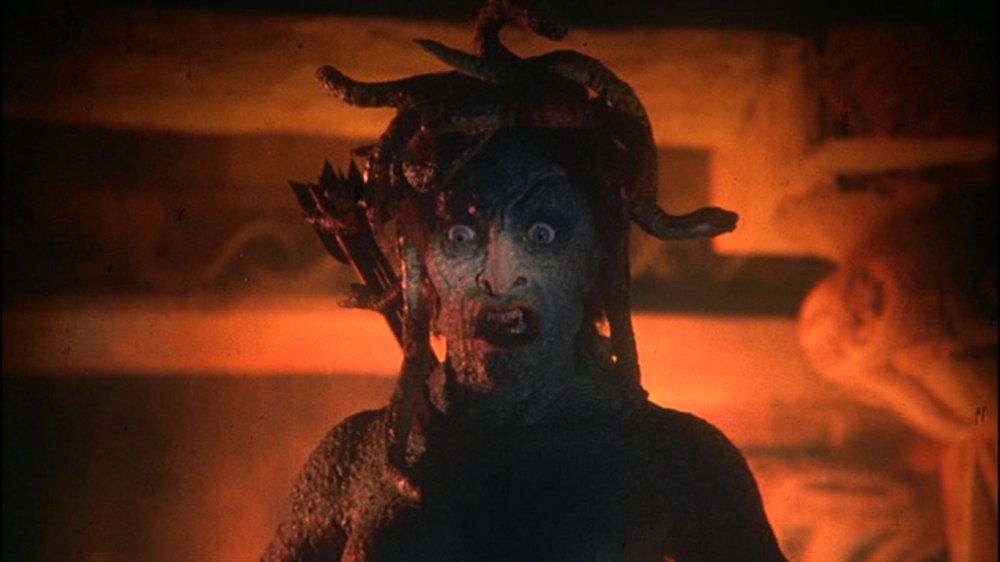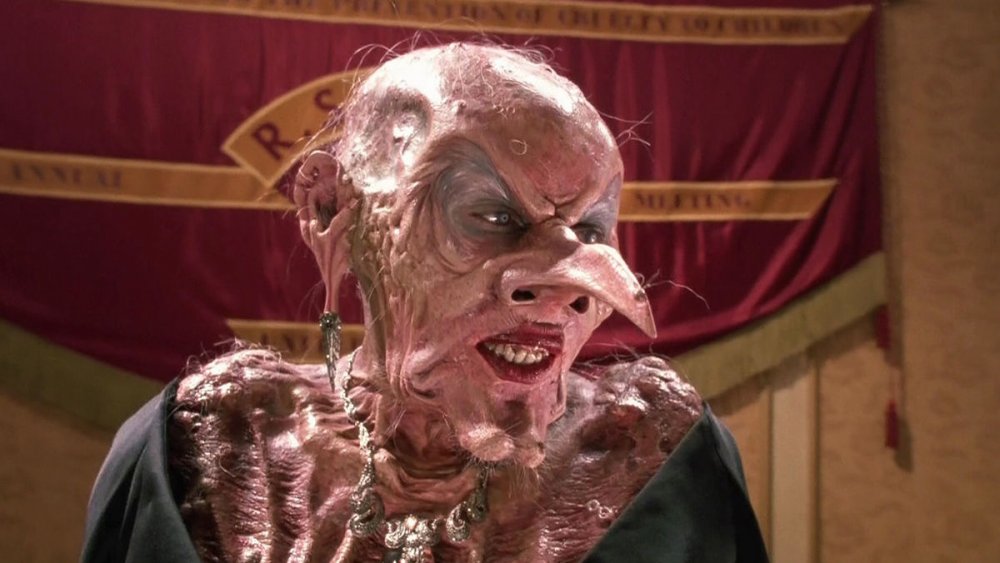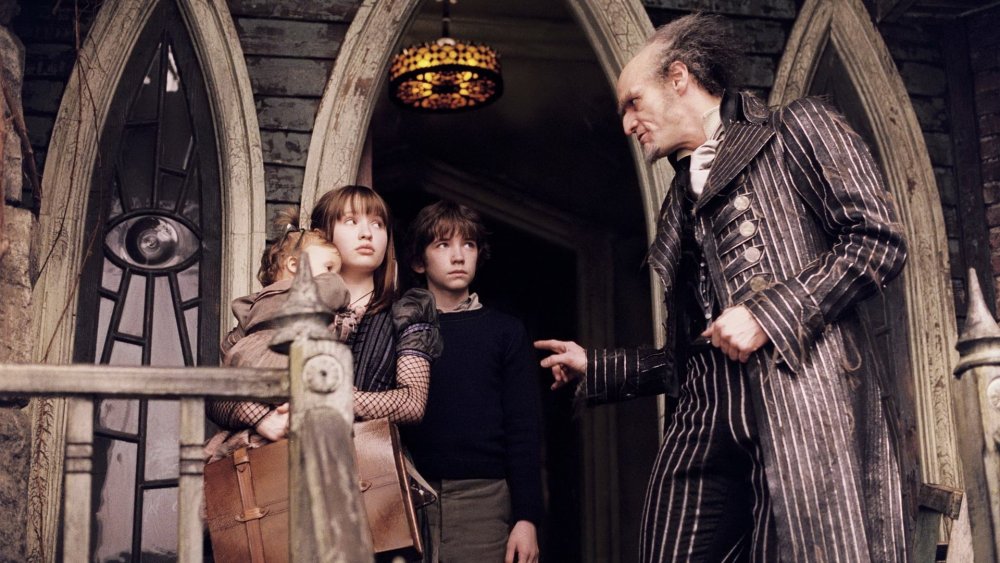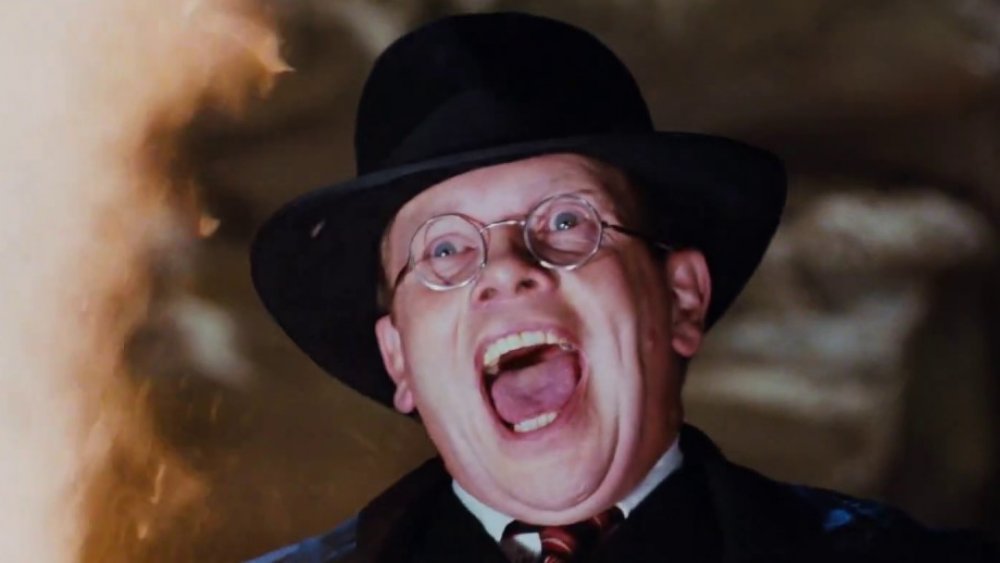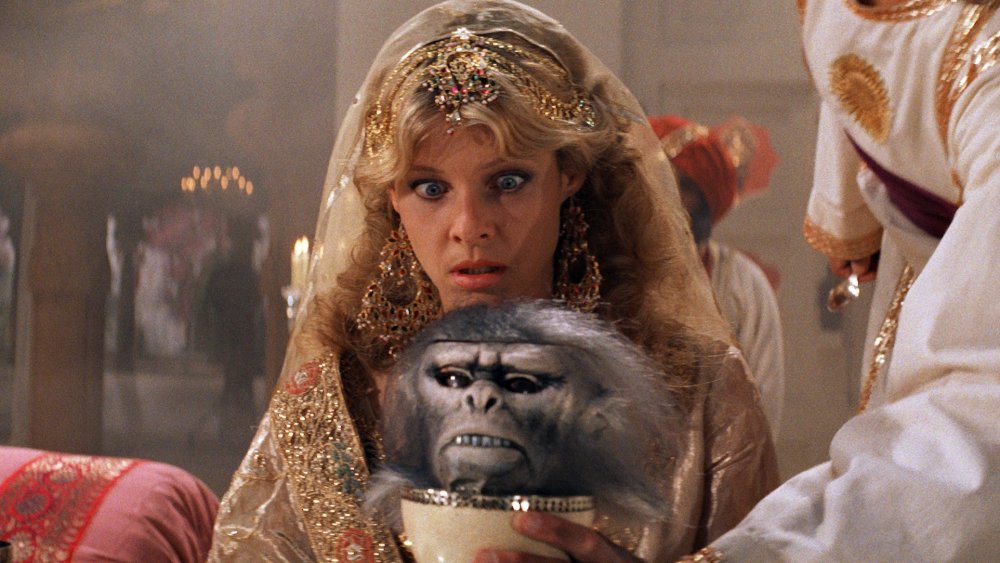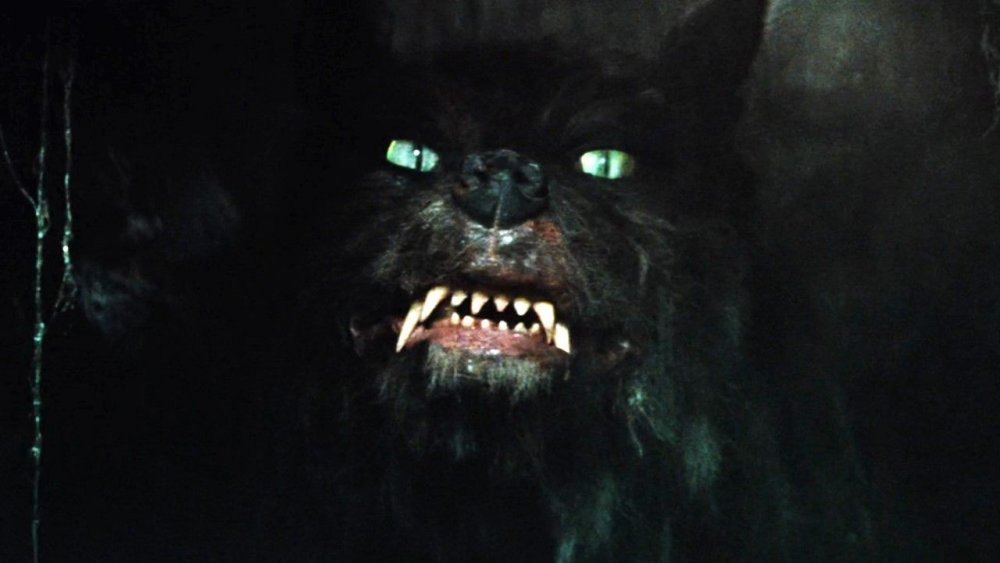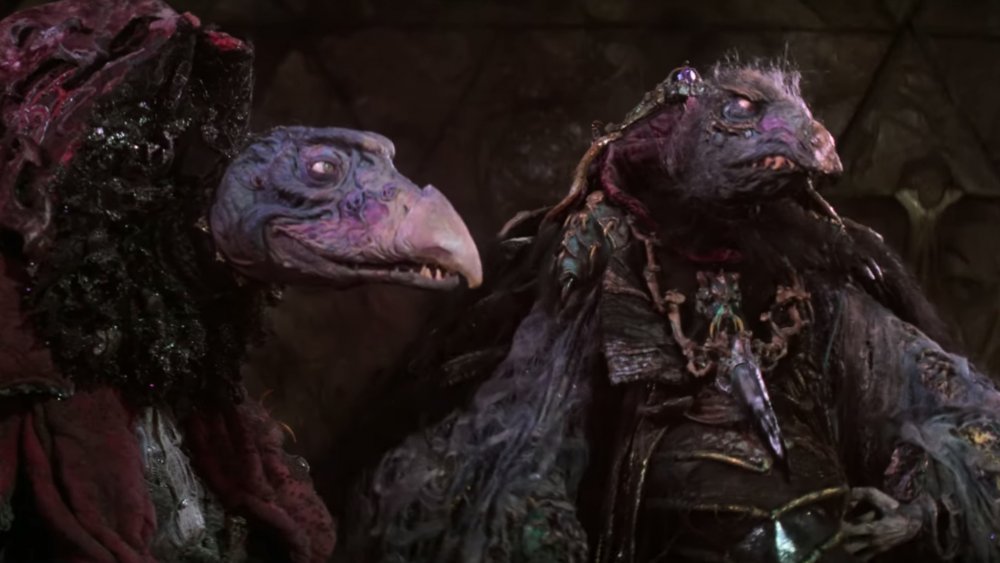Great Movies On Netflix That Terrified Us As Kids
This content was paid for by Netflix and created by Looper.
Boogeymen in the closet, monsters under your bed, creepy toys that come to life, gremlins lurking in the dark — these are just a few of the things that went bump in the night in our wandering childhood brains. Whether your parents told you a palate-cleansing bedtime story, inspected your closet, or left the hallway light on with your bedroom door slightly cracked, no matter how secure you felt for that very brief moment they tucked you into bed, you were still always convinced that a monster was one day going to claw at your feet the very moment your foot touched the floor. Let's be real here — a bulk of these outrageous fears were likely induced by the books, cartoons, and movies we absorbed as kids.
We all have a laundry list of burnt-in-the-brain imagery that psychologically scarred us for life, and the culprit isn't always some R-rated movie you happened to accidentally glimpse while the adults in the house had their movie night. Sometimes the horrific content was hovering right in front of your face in an allegedly kid-friendly flick that was intentionally developed and marketed for your young age group. Other times, it was stumbled upon in PG-rated family fare that your parents likely assumed was a safe bet — but sometimes these films contain moments of sheer violence or grotesque gore that cross the fine line between age-appropriate scares and outright horror. When these moments occurred, you either covered your eyes or couldn't look away from the screen — and this haunting imagery was now forever ingrained in the back of your cerebrum.
Back in the day, many of us came across these galvanizing flicks during a family outing at the movie theater or while exploring piles of VHS tapes rented from a local video store, but now, they're a button click away on your Netflix queue. These are some of the great films from our childhood that left a lasting impression by unintentionally scaring our pants off.
Clash of the Titans (1981)
When you're asked to think of the greatest sword-and-sandal fantasy movies from your youth, depending on when you were conceived, the first film that likely pops in your head is the 1981 version of Clash of the Titans. The sweeping Greek mythology-fueled epic starred Harry Hamlin as the heroic Perseus, backed by a supporting cast of screen legends such as Laurence Olivier as Zeus and the great Maggie Smith as Thetis. But what was far more memorable than the film's well-known thespians were the marvelous and dazzling visuals by the legendary stop-motion effects wizard Ray Harryhausen. As a child seeing Clash of the Titans for the first time, you were probably in awe as you gazed upon its many mythical beasts brought to life by the master who invented and perfected the cherished art form. Who can forget the majestic winged stallion Pegasus, or the quirky mechanical owl Bubo?
But as much as the film likely astounded you with the practical execution of its wondrous benevolent beasts, it also equally terrified you in spades with its roster of fearsome villainous creatures. The main baddie is a horned satyr named Calibos — let's just say he isn't exactly easy on the eyes, nor are the creepy, eyeless Stygian witches. Then there's the two-headed wolf Othrus, and the multi-armed leviathan known as the Kraken. While these ferocious movie monsters might've made your younger self flinch and look away from the screen, it was Medusa who most likely sent endless shivers down your prepubescent spine. Seeing her onscreen for the first time is one of those etched-in-brain cinematic moments a child won't be erasing from their memory anytime soon. In fact, they might even lose some sleep over her ghastly appearance: that squirmy serpentine hair, her haggish face, those piercing luminous eyes, her slithery movements — it's the stuff of pure nightmares. Harryhausen himself said that her big scene was "A sequence as near perfect as I was ever able to achieve." He achieved scaring the hell out of us, that's for sure.
The Witches
A well-known piece of literature that depicts the nefarious old crones better known as witches is the classic grim fairytale Hansel and Gretel — a cautionary tale very likely read to you at some point during your early formative years. Cackling old hags who kidnap and devour children? That's messed up! If the thought of being kidnapped wasn't already terrifying enough, being a meal made it far more surreal. A movie that puts its own wickedly delightful spin on the mythology is The Witches, the 1990 fantasy film directed by Nicolas Roeg (The Man Who Fell to Earth) and based on the novel of the same name by Roald Dahl. In it, orphaned 8-year-old Luke is living in Norway with his grandmother Helga — an elderly woman haunted by her own childhood experiences with the titular hags. As if losing his parents wasn't already enough mental anguish for an 8-year-old to process, Helga warns Luke about the insidious witches that populate their region and teaches him how to scope out their red flag characteristics: scratchy habits due to the wigs on their rash-riddled bald heads, gleaming purple eyes, square feet, and gloves worn to conceal their nasty meat hooks.
This knowledge comes to Luke's advantage when he spies an entire coven staying at their getaway hotel. They are masquerading as human women who are in town for a convention led by their all-powerful leader, the Grand High Witch, played to perfection by the incomparable Anjelica Huston. In a flesh-ripping ballroom scene, the witches reveal their true skin. To an adult, this scene may be appalling in a comical way, but to a young mind, it's a rather traumatic sequence. Thanks to the practical makeup effects provided by Jim Henson Productions, the Grand High Witch herself is a truly wretched sight to behold,. Every detail about her is truly grotesque: From her scabrous, scraggly-haired skin, to the hairy mole are her elongated arched nose, to the bony hunch on her back, you simply can't unsee her. The atrocious visual depictions of the witches and their blatant animosity toward children are why this movie once chilled us to the bone.
Lemony Snicket's A Series of Unfortunate Events
The very thought of being abandoned or losing a parent is likely the number one greatest primal fear of any child. From Bambi to The Lion King, it's a theme that's become a staple for most animated Disney movies. Not to single out Disney, but there are a lot of other family movies, whether they're animated or live action, that follow that same trend. Remember terrifying death of Nemo's mom at the very beginning of Pixar's Finding Nemo? Or how about the tear-jerking demise of Littlefoot's mom in The Land Before Time? Or the heart-crushing finale to A Monster Calls? Even the 1995 version of Jumanji centers around a brother and sister who lost their parents in a tragic accident. The 2004 version of Lemony Snicket's A Series of Unfortunate Events falls in the same category. The film centers around the Baudeliere children: the studious 14-year-old Violet, 12-year-old bookworm Klaus, and their spunky baby sister Sunny.
The three of them were recently orphaned due to a house fire that killed both of their parents. To make matters worse, they're assigned to the custody of a distant relative, the repulsive Count Olaf (Jim Carrey), a greedy stage actor who wants nothing to do with them. All he cares about is the vast fortune that they will inherit one day, and he'll do anything to snatch it — even if it means staging their deaths — which the miserable cretin does by intentionally placing them in situations of extreme peril. The film has a dark comedy tone that's punctuated by Carrey's maniacal and memorable performance, and baby Sunny is a scene-stealing hoot — but that doesn't mean that the overall theme isn't scary for kids. The very thought of losing both parents and then ending up in the clutches of a murderous relative makes this a terrifying viewing experience that may really rattle youngsters.
Raiders of the Lost Ark
If you've never seen Raiders of the Lost Ark or heard of Indiana Jones, one might suspect that you've been living under a rock. The beloved 1981 adventure movie directed by Steven Spielberg and produced by George Lucas went on to earn nine Academy Award nominations and ended up taking home four of the coveted gold trophies. While Raiders of the Lost Ark certainly inspired a generation of kids to don a fedora and whip and pretend to be archeologist-turned-action hero on the playground, the PG-rated movie wasn't without its horror genre-worthy moments. During the film's epic conclusion, Indiana Jones (Harrison Ford) and Marion (Karen Allen) have been captured and the fabled Ark of the Covenant has been intercepted by the Nazis led by the ruthless Major Arnold Toht and Indy's rival archeologist Rene Tolloq.
They believe the Ark will grant them invincibility, but before they deliver the relic back to Adolf Hitler, Telloq wants to test this theory out, and oh boy, does he learn the hard way that curiosity does indeed kill the cat. When the Ark is opened during a ceremony, it unleashes vengeful apparitions who decimate the entire Nazi platoon. In one particularly graphic moment, Telloq and Toht are engulfed by ghostly flames, and there's literal bloody face-melting reminiscent of the gory practical effects you would expect to see in a horror joint like the original Evil Dead. There's even a head explosion a la David Cronenberg's Scanners. It's a gruesome sight to behold and one you might not expect in a PG-rated movie, but hey, that was the 1980s for you.
Indiana Jones and the Temple of Doom
Raiders of the Lost Ark's 1984 prequel, Indiana Jones and the Temple of Doom, is also PG-rated — although it famously served as the final straw with the MPAA, who would go on to create a new PG-13 rating not long after the movie's release. If you thought head explosions and gooey face-melting scenes were unsettling, well, Temple of Doom ups the body horror a few notches with actual heart-ripping and a gross-out dinner scene. Set in 1935 (a year before the events of Raiders), Indiana Jones (Harrison Ford) finds himself in Pankot Palace where he faces off against the ruthless Mola Ram, a high priest who has the magical ability to extract hearts from the chest cavities of his victims. He leads a cult of Kali worshippers who offer human sacrifices to the god in an underground temple below the palace. It's in these human sacrifice scenes that the movie hovers within that disturbing body horror realm that no doubt traumatized theaters full of pre-teens.
When Mola Ram punctures through the chests of his victims, the practical effects look real. You'll likely clutch your own chest as his hands pierce through flesh like butter, or you might feel a sense of heartburn as he yanks the still-throbbing, blood-drenched heart from a photorealistic torso. There was no CGI in 1984 — so everything you see onscreen had to be, no pun intended, fully fleshed out. But there was nothing more traumatizing and gag-inducing for youngsters than the infamous palace dinner scene — monkey brains, anyone? The demented delicatessen also featured giant scarab beetles, eyeball soup, and baby snakes. The gum-spitting expression that Short Round had during the "snake surprise" moment was likely the very same look on any child's face in the movie theater as that scene played out. Those yucky beets and brussels sprouts your parent always tried to force you to eat probably seemed mighty delicious after experiencing this scene. Temple of Doom has an abundance of burnt-in-your-memory moments that will certainly test the gag reflexes of queasy viewers — so it's no wonder that it sparked the MPAA to reevaluate their ratings system.
The NeverEnding Story
Ask any child of the 1980s to list the most traumatizing and gut-wrenching films they recall from their youth, and you're guaranteed to see Wolfgang Peterson's The NeverEnding Story make the cut. This 1984 fantasy centers around Bastian, a young boy who is transported to the magical world of Fantasia. While engulfing himself in book called The Neverending Story, Bastian is merely a spectator as he reads about a young warrior named Atreyu (Noah Hathaway) who is chosen to go on a perilous journey to rid Fantasia of the Nothing — a dark, shapeless force that's consuming the entire land. But Bastian soon realizes that he has a key role to play: This book he's reading is more than just a story, and he discovers that the characters within its pages are aware of his existence. The NeverEnding Story is riddled with heartbreak, terror, and other realistic themes that might pack a close-to-home punch for some kids. For starters, Bastian is coping with his mother's recent death while also dealing with bullies at school. These two heavy topics alone will, sadly, strike a deep chord with some kids. The film is also not without its nightmare-fueled monsters.
The Nothing dispatches a giant wolf-like creature named Gmork who relentlessly pursues our hero Atreyu throughout the film's runtime. His ferocious, scarred appearance and enlarged glowing eyes would be suitable for any werewolf horror movie — his fur is mangy and damp, and the jaws of his battle-worn muzzle are slightly tinged with blood as if he just snacked on a fresh kill. When The NeverEnding Story isn't busy unnerving you with its many hair-raising moments, it's probably busy building an enormous lump in your throat. The mother of all ugly cry moments in a kid's movie definitely has to be the infamous Swamps of Sadness scene. Here, Atreyu and his trusty steed Atrax are sluggishly tromping their way through endless muddy plains as Bastian narrates the grim risk of venturing through the swamp — those who let the sadness overtake them will sink and perish within its depths.
Artax suddenly comes to a halt and slowly begins to sink. Screaming and pulling with all his might as his eyes erupt in tears, Atreyu desperately tries to save his horse — but it's no use, the horse has succumbed to the sadness and is soon submerged up to its neck in mud. It's a grueling scene to watch, and Hathaway's soul-crushing performance makes it even harder to bear. The scene fades to black and cuts to a lonely shot of Atreyu mourning over a bubbly patch of mud followed by a heartbreaking shot of Bastian, who's no doubt bawling along with the viewer. Accentuated by the melancholic score provided by Giorgio Moroder, it's an emotionally impactful scene that absolutely destroyed us as kids.
The Dark Crystal
In the 1982 fantasy film The Dark Crystal, puppetry wizard Jim Henson transported audiences to the world of Thra and captivated viewers with its wondrous landscapes populated by a colorful array of beings such as the Mystics, Gelflings, and the evil Skeksis. When first came out, it was prominently advertised as a new film from the dude who made the Muppets. With its visually spectacular imagery and cute n' fuzzy creatures such as the pooch-like furball known as Fizzgig or the button-nosed Podlings, it's no surprise that parents flocked to theaters with their children in tow. After all, the film was rated PG, a rating that simply warns that "some material may not be suitable for children." But this was 1982 — a time when films such as Poltergeist, also released that year, had the same rating. We all know how terrifying the latter movie was. Little did many unsuspecting parents know that The Dark Crystal is really a horror film in disguise.
Take a glance at the villainous Skeksis and you'll see that that argument isn't entirely exaggerated. The very sight of these vulture-like reptilian creatures is sure to knock the socks off toddlers, along with the equally menacing Garthim — hulking crustacean-like creatures with large pincers who create their fair share of onscreen chaos. There's a scene when these relentless armored brutes raid a Podling village. The poor, lovable little creatures, including their infants and elderly ones, are seen running in peril, violently snatched, and stuffed in cages. There's even a scene when they take down and seemingly kill a Landstrider — a peaceful and elegant quadruped creature that our heroes use as steeds. And as if the Podlings hadn't already suffered enough, the evil Skeksis also drain their essence and reduce them to pale, mindless zombies in another truly messed-up scene. Even the benevolent Gelfings, the heroes of this story, have an odd and eerie appearance. And let's not forget the one-eyed Aughra. Even though she's one of the good guys, children may find her appearance to be as dreadful as the Skeksis.
